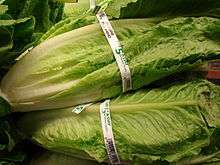Romaine lettuce


Romaine or cos lettuce is a variety of lettuce (Lactuca sativa L. var. longifolia) that grows in a tall head of sturdy leaves with firm ribs down their centers. Unlike most lettuces, it is tolerant of heat.
Origin and etymology
In English, the most common name in North America is "romaine", while elsewhere it is known as "cos lettuce".[1] Many dictionaries trace the word cos to the name of the Greek island of Cos, from which the lettuce was presumably introduced.[2] Other authorities trace cos to the Arabic word for lettuce, khus خس [xus].[3]
It apparently reached the West via Rome, as in Italian it is called lattuga romana and in French laitue romaine, both meaning 'Roman lettuce', hence the name 'romaine', the common term in North American English.[3]
Cuisine
In North American supermarkets, romaine is very widely available year-round.[4]
The thick ribs, especially on the older outer leaves, should have a milky fluid which gives the romaine the typically fine-bitter herb taste.
Romaine is a common salad green, and is the usual lettuce used in Caesar salad. Romaine lettuce is commonly used in Middle Eastern cuisine.
Romaine, like other lettuces, may also be cooked, for example braised or made into soup.[4]
Ritual use
Romaine lettuce may be used in the Passover Seder as a type of bitter herb, to symbolise the bitterness inflicted by the Egyptians while the Israelites were slaves in Egypt.[5][6]
Nutrition
| Nutritional value per 100 g (3.5 oz) | |
|---|---|
| Energy | 72 kJ (17 kcal) |
|
3.3 g | |
| Dietary fibre | 2.1 g |
|
0.3 g | |
|
1.2 g | |
| Vitamins | |
| Vitamin A equiv. |
(36%) 290 μg |
| Folate (B9) |
(34%) 136 μg |
| Vitamin C |
(29%) 24 mg |
| Minerals | |
| Calcium |
(3%) 33 mg |
| Iron |
(7%) 0.97 mg |
| Phosphorus |
(4%) 30 mg |
| Potassium |
(5%) 247 mg |
| Other constituents | |
| Water | 95 g |
| |
|
Percentages are roughly approximated using US recommendations for adults. Source: USDA Nutrient Database | |
As with other dark leafy greens, the antioxidants contained within romaine lettuce are believed to help prevent cancer.[7]
Other
The day of 22 Germinal in the French Republican Calendar was dedicated to this lettuce, as "Romaine".[8]
Notes
- ↑ Walker, Norman Wardhaugh (1970). "Cos or Romaine Lettuce Juice". Fresh Vegetable and Fruit Juices: What's Missing in Your Body?. Book Publishing Company. Retrieved 2 December 2013.
- ↑ Oxford English Dictionary, First Edition, 1893, s.v. 'cos'
- 1 2 "Cos lettuces are probably not named for the island of Kos but for the Arabic word for lettuce', Alan Davidson, The Oxford Companion to Food, s.v. 'lettuce'. Oxford University Press 1999. ISBN 0-19-211579-0.
- 1 2 Mark Bittman, "The Charms of the Loser Lettuces", New York Times, April 2, 2010 full text, recipe for "Braised Romaine Hearts"
- ↑ Bradshaw, Paul; Hoffman, Lawrence (August 19, 2000). "Towards a History of the Paschal Meal". Passover and Easter: Origin and History to Modern Times. University of Notre Dame Press. ISBN 9780268038595.
- ↑ Ronald L. Eisenberg, Jewish Traditions: A JPS Guide, Jewish Publication Society, 2010, ISBN 0827610394 p. 286
- ↑ American Institute for Cancer Research, "Foods That Fight Cancer: Dark Green Leafy Vegetables".
- ↑ Tooke, William. The Monarchy of France: its rise, progress, and fall, p. 634
References
- Kirschmann, John D. & Dunne, Lavon J. Nutrition Almanac, s.v. ISBN 0-07-034906-1.
External links
-
 The dictionary definition of romaine at Wiktionary
The dictionary definition of romaine at Wiktionary